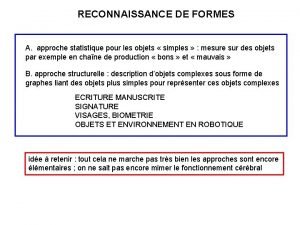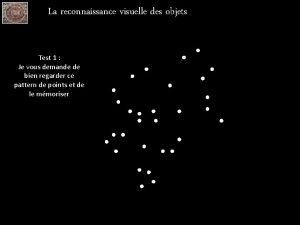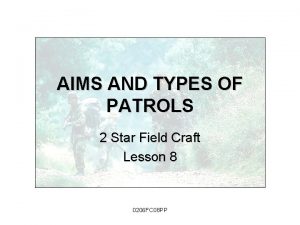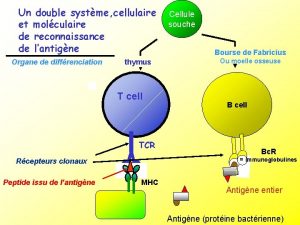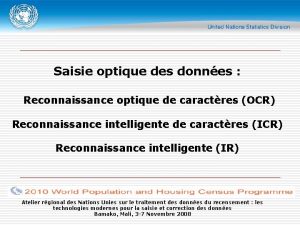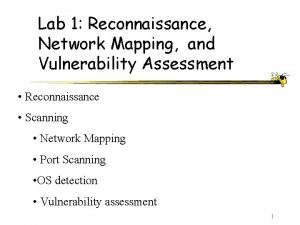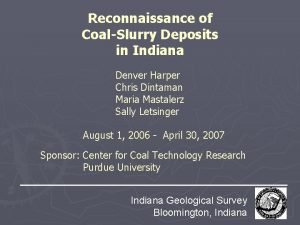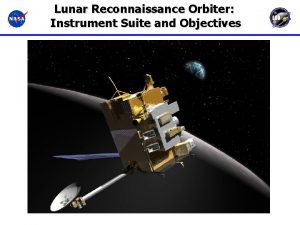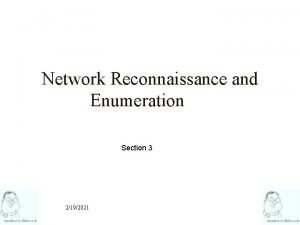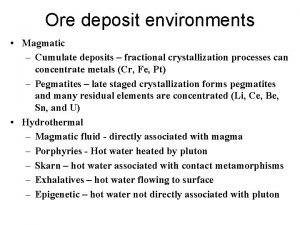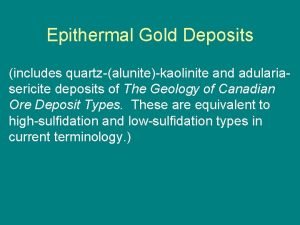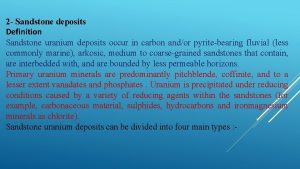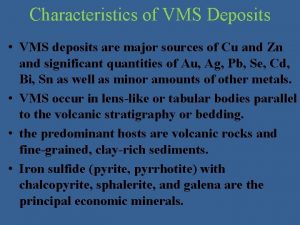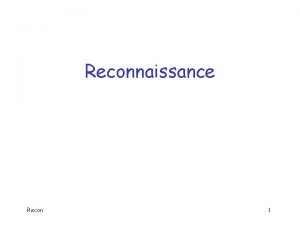Reconnaissance of CoalSlurry Deposits in Indiana Denver Harper
























- Slides: 24

Reconnaissance of Coal-Slurry Deposits in Indiana Denver Harper Chris Dintaman Maria Mastalerz Sally Letsinger August 1, 2006 - April 30, 2007 Sponsor: Center for Coal Technology Research Purdue University Indiana Geological Survey Bloomington, Indiana

IGS Web Report http: //igs. indiana. edu/survey/projects/Coal_Fines/index. cfm

Definitions Spoil = displaced overburden Gob = coarse-grained refuse Slurry (tailings) = fine-grained refuse Spoil (Fragmented and displaced overburden) Surface Mine-Run Coal (Raw Coal) Ash Power Plant Preparation Plant (Washer) Clean Coal Reject (Refuse) Coarse-grained (gob) Fine-grained (slurry, tailings)

Objectives Rapid reconnaissance using existing data in a GIS Map areal extents of coal-slurry deposits Estimate thicknesses Calculate volumes Collect preexisting chemical analyses Statistically analyze chemistry values

Mapping – Data Sources Historical aerial photographs Dates: 1937 to 1980 Source: IGS archive (160 photos) Digital Orthophoto Quarter Quads (1998) National Agricultural Imagery Program (2003) Indiana Orthophotography Project (2005)

Mapping – Feature Identification Coal-preparation plants Old Ben No. 2 2003 Tecumseh 1953 Pre 1978 Post 1978

Mapping – Feature Identification Coal slurry deposits Slurry (fine-grained) Friar Tuck Mine 1974 Gob (coarse-grained)

Mapping – Depositional Settings Berms Minnehaha - 1954 Final-cut pit Airline - 1949 Spoil Chieftain 1946 1954

Mapping – Complex Histories

Results – Areal Extents Area (acres) Berms 1, 213 Final-cut pits 764 Spoil deposits 788 Total 2, 765 Berm Final-cut pit Spoil Impoundment Not slurry

Thickness Estimates – Data Sources Existing data sets: Topography - Digital Line Graphs (USGS) Coal Mine Information System (IGS) Drilling data - National Coal Resource Data System (USGS) Historical aerial photographs

Thickness Estimations - Berms Air Quality No. 1 2003 (NOTE: Active operation. Impoundment not yet filled. Not included in final calculations. ) Elevation of top of berm ~ 545 ft Elevation of bottom of impoundment ~ 445 ft Total height of Impoundment ~ 100 ft

Thickness Estimations – Final-cut pits Lynnville Mine Elevation of coal ~ 395 ft Elevation of top of final-cut pit ~ 470 – 500 ft Depth of final-cut pit ~ 75 to 105 ft

Thickness Estimations – Spoil deposits Assumptions: (1) Troughs completely filled. (2) Angle of draw = 30 degrees. (3) Aver. thickness = 1/8 ridge spacing. Latta Mine 1954 Ridge spacing = 66 feet Average depth of troughs = 66/8 = ~ 8. 25 ft

Results – Thickness Estimations Thickness Estimates (feet) Range Average Berms 0 to 54 10 to 14 Final-cut pits 0 to 125 38 to 56 Spoil deposits 0 to 49 6 to 8

Results – Volumetric Calculations Volumetric estimates (million cubic yards) Berms 29 to 39 Final-cut pits 56 to 86 Spoil deposits 9 to 12 Total 94 to 136

Recoverable Coal - Assumptions Mineability of slurry Final-cut pits = 70 percent Spoil deposits = 60 percent Average weight density of raw slurry = 110 to 120 lbs per cubic foot Recoverable coal = 20 to 40 percent of mineable slurry Volume of raw slurry in situ = 94 to 136 million cubic yards = 22 to 69 million tons of recoverable coal “…volume of mapped CSDs represents from 22 to 69 million tons of recoverable coal. This compares with an earlier estimate made by Miller and Eggert (1982) of about 20 million tons. ” - Final Report

Chemical Characterization Mine sites – 10 Drill holes – 93 Samples – 473 Collection dates – 1970 s through early 1980 s Analyses Sulfur (weight percent, as received) Ash (weight percent, as received) Btu per pound (as received, moisture- and ash-free)

Selected statistical values for 473 individual samples of coal slurry AR: as-received; MAF: moisture- and ash-free; wt %: weight percent Ash, AR (wt %) Sulfur, AR (wt %) Btu/lb, AR Btu/lb, MAF Minimum 5. 6 0. 4 1069 3725 Maximum 76. 8 23. 7 11720 24975 Average 32. 2 4. 0 7095 12849 Mode 26. 7 2. 8 7540 13210

Selected statistical values for samples from various mine sites AR: as-received; MAF: moisture- and ash-free; wt %: weight percent Mine ID_IGS No. of drill holes No. of samples Ash AR (wt %) Sulfur AR (wt %) Btu/lb AR Btu/lb MAF Minnehaha D 3 18 74 20. 2 2. 2 6893 13680 Green Valley B 4 9 23 20. 9 5. 1 9780 13305 Otter Creek B 1 4 4 26. 7 2. 6 8893 13025 Friar Tuck D 4 9 37 28. 1 2. 1 8092 13663 Buckskin K 3 7 17 29. 0 2. 7 8589 12873 Chinook C 1 14 81 30. 5 3. 2 5577 13310 Lynnville K 1 6 36 35. 0 4. 3 8150 13344 Tecumseh K 2 4 28 35. 9 8. 9 7168 11942 Airline E 3 11 99 42. 4 4. 4 7143 12657 Hawthorn E 4 11 55 45. 2 5. 8 6608 11920 93 454 31. 4 4. 1 7689 12972 SUM AVERAGE

Slurry Disposal Preparation plant pipeline pipe discharge = “entry point” Cell 2 large, dense fragments of coal and rock Cell 1 subaerial fan slurry pond coarse coal ultrafine coal and clay “…a manmade prograding fan-delta system” -- Eggert, Miller, and Irwin (1980)

Chinook - IGS Sample Locations 1996 Spreadsheet: COAL_SLURRY_ANALYSES_IGS. XLS 1946

Chemical Trends – IGS Samples Spatial trends – Mixed results. Significant trends within several CSDs (Chinook and Lynnville), but not within others. Historical trends – Age of preparation plant versus quality of coal slurry Source coal beds – Quality of source coalbed versus quality of slurry Type of mining – Underground mines versus surface mines

“Loss of slurry or fines in washeries…is a step in the march of progress and eventually some method of utilization will be found. ” - Coal Age, 1936
 Mounim el yacoubi
Mounim el yacoubi La reconnaissance est la mémoire du coeur
La reconnaissance est la mémoire du coeur Reconnaissance visuelle des objets
Reconnaissance visuelle des objets Cue card mc design
Cue card mc design Reconnaissance magnetic
Reconnaissance magnetic Prc-137 hf radio
Prc-137 hf radio Aircraft reconnaissance
Aircraft reconnaissance What are the aims of patrolling
What are the aims of patrolling Manoeuvre lspcc reconnaissance d'appartement
Manoeuvre lspcc reconnaissance d'appartement Reconnaissance strike group
Reconnaissance strike group Reconnaissance tih
Reconnaissance tih Reconnaissance
Reconnaissance Double reconnaissance
Double reconnaissance Reconnaissance intelligente de caractères
Reconnaissance intelligente de caractères Network mapping reconnaissance
Network mapping reconnaissance Reconnaissance in to kill a mockingbird
Reconnaissance in to kill a mockingbird Lunaf.com 14.01.2004
Lunaf.com 14.01.2004 Network reconnaissance tools
Network reconnaissance tools The multiple expansion of checkable deposits
The multiple expansion of checkable deposits Calcium deposits
Calcium deposits Ore deposits
Ore deposits As coal deposits were used up, britain turned to
As coal deposits were used up, britain turned to Glacial deposits
Glacial deposits Sedex ore deposits
Sedex ore deposits Mvt deposits
Mvt deposits
